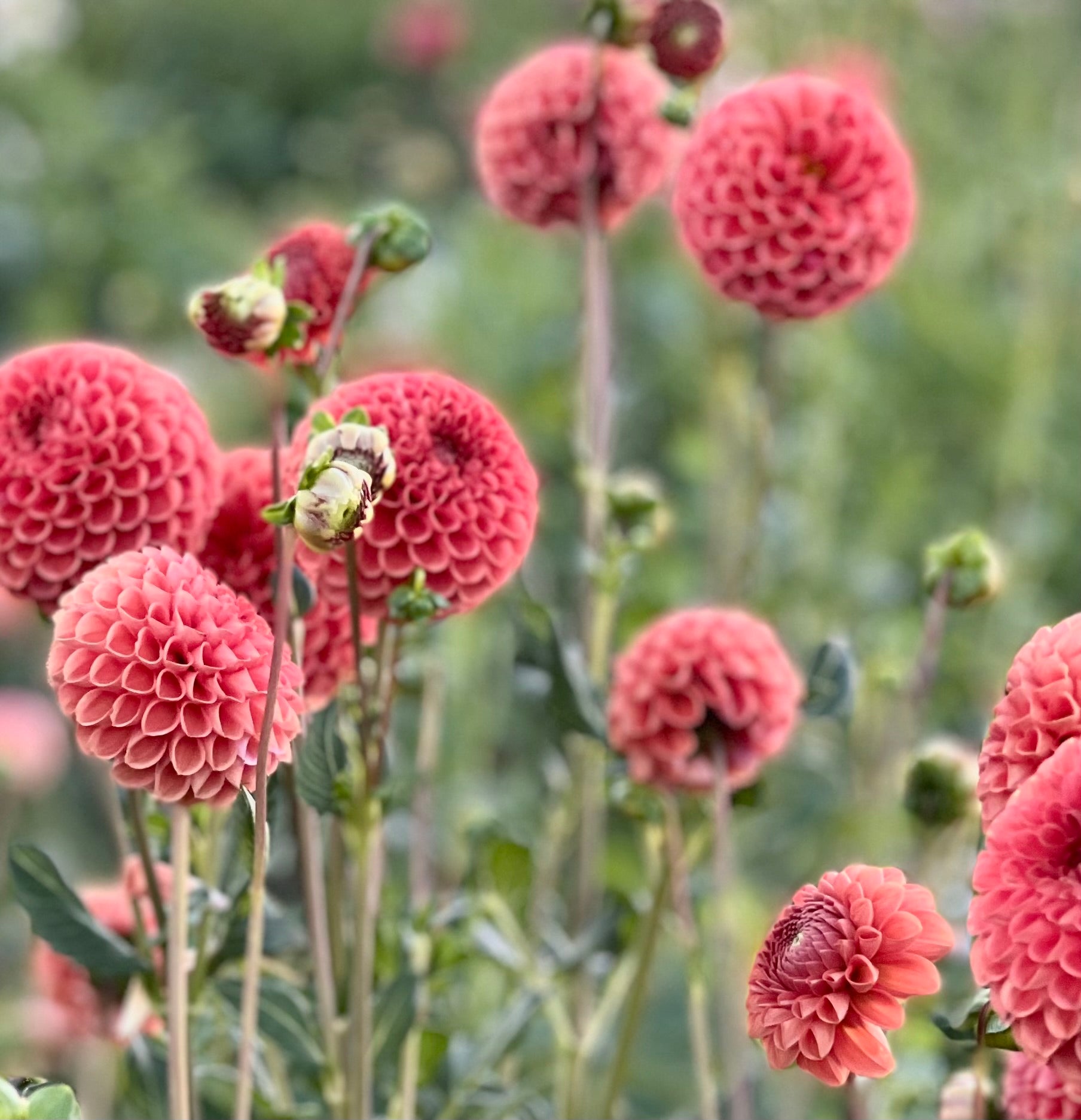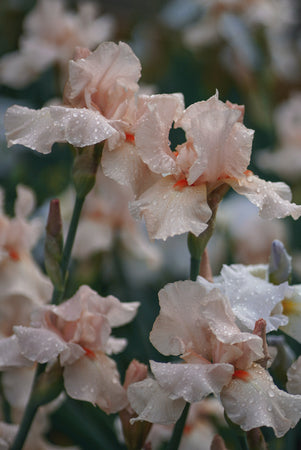Planting and Caring for Dahlias to get the most Flowers for Cutting

So you want to grow dahlias for cut flowers, if this is your first time growing dahlias, you may have many questions. Let’s go over all the basics to growing and caring for dahlias to maximize the amount of flowers you get from each plant.

“Everyone should grow more flowers”


Comprehensive guide to dahlia growing and care
When growing dahlias, it helps to understand what their needs are, first off they like sunshine. At least 6 hours of direct sun is needed, full sun all day is great unless you live in a hot southern climate, in which case 6 hours of morning sun would be best, followed by afternoon shade or dappled shade. If dahlias do not receive enough sun, they will get leggy and weak because they are reaching for more light and they will not bloom like they should.
The next thing to consider when growing dahlias is the soil. Dahlias like a nice, rich, well draining soil. Add several inches of compost and a well balanced organic fertilizer and mix well with your soil before planting. If you have heavy, clay soil this is especially important as dahlias do not like to sit in water and tend to rot easily since they are a large tuberous root system. Well draining soil is ideal, do what you can to achieve this, if your soil is poorly draining, where water stands for a long time after a rain, consider using raised beds or pots.
Dahlias are frost sensitive, so wait until all danger of frost is passed before planting them out, ideally your soil temperature would be 60 degrees F when planting. If you are unsure of your last expected spring frost date, Google is your friend, just type in “last spring frost date” and your zip code and you will have an answer.
When planting, dig a hole 4-6” deep and lay the tuber horizontally with its growing eye facing up, then cover with soil. As with all plants, labeling is key so you remember where your dahlia is located and what variety it is. It is also time to put a stake in by your dahlia so you don’t harm the tubers later if you need to stake it during the growing season. If you plan on staking which is suggested if you aren’t planting close together in rows and if you get windy and stormy weather during the growing season. I do not stake my dahlias, but I grow them closely at 12-18” apart and they end up supporting each other, and here where I grown in southwest Washington, we get virtually no rain or wind all summer long until the end of the growing season. There is one variety I will stake next year though and that is Big Brother, it was very floppy and top heavy but oh so beautiful!
Once you have planted your dahlias you do not water them, the tubers have the energy they need to send up the green sprouts and first roots, once they are actively growing above soil level, begin watering them. This typically occurs 1 month after planting them in the ground. Make sure you have a watering system in place, drip irrigation is suggested because once dahlias are actively growing, they like to be watered well, this helps them put on new green growth and later it helps them produce flowers.
Here you will need to understand your soil drainage, I water deeply once a day during the hot summer months because I have a well draining, sandy soil. Stick your finger down into your soil to judge how well your soil is retaining moisture. Adjust your watering based on how the soil feels, it should not be dry, and it should not be wet, moist is just right. Remember in the hot summer months to pay close attention to watering your dahlias, this is also the time to mulch around the root zone to help conserve moisture and avoid the soil heating up too much, especially for southern growers.
As your dahlias are growing, keep them weeded and once they have 4-6 leaf sets, pinch out the growth tip above the 4th or 5th leaf set. Pinching dahlias stimulates them to start branching instead of growing one big fat stem. They will send out new branches at the junction of the leaf set and the stem, each branch means more flowers. Trust me on this one, you do not want the big thick stems that come if you do not pinch your dahlias.
When your dahlias are tall enough you can use twine to tie them to the stake you have put in the ground, and now you just let them grow, keep them weeded and watered and wait for the first blooms.
The first dahlias should start blooming about 8 weeks after planting in the ground, but every variety is different, some are early bloomers and others are late bloomers. The weather also plays a part, but once your dahlias are blooming, it is time to start harvesting.
The more you harvest your dahlias, the more blooms they will send up, and the better your tuber harvest will eventually be. When I first started growing dahlias, I wasn’t sure where to cut the stems when I was harvesting and I cut them too short. When cutting stems, it is like you are training your dahlia what kind of stems you want it to produce. If you cut long stems, about 15” long, the dahlia will produce more long stems for you. If you cut short stems, you will get more short stems, so cut them long.


Continue harvesting and deadheading all season long
To keep your dahlias producing, keep harvesting, if you stop harvesting, the dahlia heads will get pollinated and start to go to seed, once a plant produces seed it has fulfilled its life cycle and will start to wind down production. When harvesting, early morning or evening is best, try to avoid the heat of the day. Look for flowers that are about 2/3 of the way open for better vase life. A good way to judge the age of a dahlia bloom is by looking at the back of the bloom, older blooms start to turn brown on the back even though the front is still beautiful. We cut our dahlias and strip the lower 2/3 of the stems leaves off and put them directly into water. Don’t forget to change the water frequently and use flower food for best vase life.
If you haven’t kept up on harvesting, you will want to go through the dahlias and cut off all of the old blooms so your plants will continue to produce more new and beautiful flowers. This is called deadheading and is a necessity to keep those plants blooming. You can continue to cut and harvest dahlias until the first frost in the fall when they will turn black and mushy overnight after being hit with a hard frost. Many gardeners and farmers refer to this first frost as ‘Frostmas’ signaling the end of the growing season.
Once your dahlias have been hit with frost you can cut the stems down, most growers wait for few weeks after their first frost to dig up their dahlias. In order to keep your dahlias year after year, those in zones 7 and below dig their tubers up and store them for the winter. Another reason to dig the tubers even if you live in a warmer climate would be do divide them and therefore increase then amount of dahlia tubers you can plant next season.
I have dug my tubers and I have left them in the ground, I am in zone 8. They overwintered well in the ground but I have sandy, well draining soil, so even though we get a lot of rain here in the PNW the soil where I am at drains well, so I did not experience my dahlia tubers rotting in the ground. Some people cover their ground with a landscape tarp and mulch where their tubers are for extra protection.
When digging tubers, I leave the dirt on them, just shaking what I can off when lifting the clumps, then put them into big bulb crates and storing them in an insulated, unseated room that stays about 45 degrees all winter long. I continue to monitor the temperature and humidity levels aiming for around 85% humidity, if it gets too high I run a dehumidifier to keep the mold at bay. You can also run an air purifier for the inevitable mold spores, and check through the tubers regularly for rotten tubers or mold. Surface mold on the tubers can be cleaned off, but if the growing eye and neck are affected I toss the tuber. I find that keeping the dirt on the tubers help retain the correct humidity levels and the tubers do not shrivel and dry up in storage. If your humidty levels get too low you can put water on the floor of your storage room.
We divide our tubers in the winter or spring, I will cover dividing in another post. I hope this gives you confidence to give growing dahlias a try, you will be rewarded with lots of flowers to cut and share if you do.
Resource for further information about hot climates: Growing dahlias in hot climates


Comments